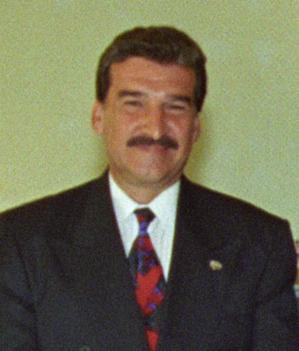Ramiro de León Carpio facts for kids
Quick facts for kids
Ramiro de León Carpio
|
|
|---|---|

León Carpio in 1993
|
|
| 31st President of Guatemala | |
| In office 6 June 1993 – 14 January 1996 |
|
| Vice President | Arturo Herbruger |
| Preceded by | Gustavo Espina |
| Succeeded by | Álvaro Arzú |
| Ombudsman of Guatemala | |
| In office 13 August 1987 – 6 June 1993 |
|
| Preceded by | Gonzalo Menéndez de la Riva |
| Succeeded by | Jorge Mario García Laguardia |
| Personal details | |
| Born | 12 January 1942 Guatemala City, Guatemala |
| Died | 16 April 2002 (aged 60) Miami, United States |
| Political party | Independent (until 1999, since 2002) |
| Other political affiliations |
Guatemalan Republican Front (1999 – 2002) |
| Spouses | Mayra Duque, Maria Eugenia Morales |
| Children | 3 |
Ramiro de León Carpio (born January 12, 1942 – died April 16, 2002) was an important leader in Guatemala. He served as the President of Guatemala from June 6, 1993, to January 14, 1996. Before becoming president, he was known for defending human rights in his country.
Contents
Early Life and Career
Ramiro de León Carpio studied law at two universities in Guatemala. He worked for the government in different roles. From 1967 to 1969, he was part of the Ministry of Economy. Later, he worked on trade and economic matters.
In 1970, he became a key secretary for national economic and political integration. He also joined a political group called the National Liberation Movement. During the presidency of Carlos Arana, de León Carpio was a general secretary for a state advisory board. After this, he worked in the private sector for sugar producers.
Working for Change
Ramiro de León Carpio helped create a new political party. It was called the Unity of the National Center (UCN). This party wanted to stop strict rule and promote more freedom. In 1984, he became one of the 21 deputies in the Congress.
He played a big part in writing the 1985 Constitution. This important document is still used today. He supported his cousin, Jorge Carpio, who ran for president in 1985. After his cousin lost, de León Carpio left the UCN party.
A Champion for Human Rights
In 1989, Ramiro de León Carpio became the Defensor del Pueblo. This means "People's Defender" or human rights ombudsman. In this role, he could speak out against human rights abuses. He made sure that people heard about unfair actions by those in power. However, he did not have the power to stop these abuses directly.
President of Guatemala
How He Became President
On May 25, 1993, the president at the time, Jorge Serrano, tried to take over the government. He ended the constitution and closed the Congress. He also ordered de León Carpio's arrest. But de León Carpio escaped by climbing over rooftops. He then spoke out against the takeover.
On June 1, President Serrano was forced to leave the country. The army wanted to make the Vice-President, Gustavo Espina, the new leader. But de León Carpio had already said Espina broke the law. On June 5, Espina resigned. The Congress then voted for Ramiro de León Carpio to become president. He was sworn in quickly and served until January 14, 1996.
Leading the Country
As president, de León Carpio promised to protect people's freedoms. He also wanted to follow the law and work towards peace. He aimed to improve the armed forces. He replaced the defense minister, General José Domingo García Samayoa.
Sadly, on July 3, his cousin Jorge Carpio was killed. Jorge was helping with peace talks. On August 26, de León Carpio asked all members of Congress and the Supreme Court to resign. This caused a big problem that lasted until November 16. It led to 43 changes to the 1985 Constitution. People approved these changes in a special vote in January 1994.
Working for Peace and Rights
On January 6, 1994, peace talks began with a main rebel group, the URNG. The United Nations and the Organization of American States (OAS) helped with these talks. On March 29, de León Carpio signed an important agreement on human rights. This agreement asked for the disbanding of certain civilian patrols. These patrols had been accused of bad actions during the Civil War.
During his time as president, there were some difficult moments. The chief of the Supreme Court was killed in April 1994. Also, in October 1995, there was a sad event involving soldiers and civilians. These events caused tension. But despite this, free elections were held under his leadership. In August 1994, many seats in Congress were up for election. In November 1995, a new presidential election was held. Álvaro Arzú won and became the next president in January 1996.
After His Presidency
In October 1996, Ramiro de León Carpio became a deputy in the Central American Parliament. For several years, he worked as an international advisor. He also helped monitor elections for the OAS.
In 1999, he joined a political party called the Guatemalan Republican Front (FRG). He was elected to Congress in November. But on March 11, 2002, he resigned from Congress and the party. He said he wished he had never joined. He planned to write his life story and continue international work. However, he passed away on April 16, 2002, while visiting Miami, United States. He likely died from a health issue. Guatemala declared a period of national mourning. He received a state funeral and was honored with a special award after his death.
See also
 In Spanish: Ramiro De León Carpio para niños
In Spanish: Ramiro De León Carpio para niños

